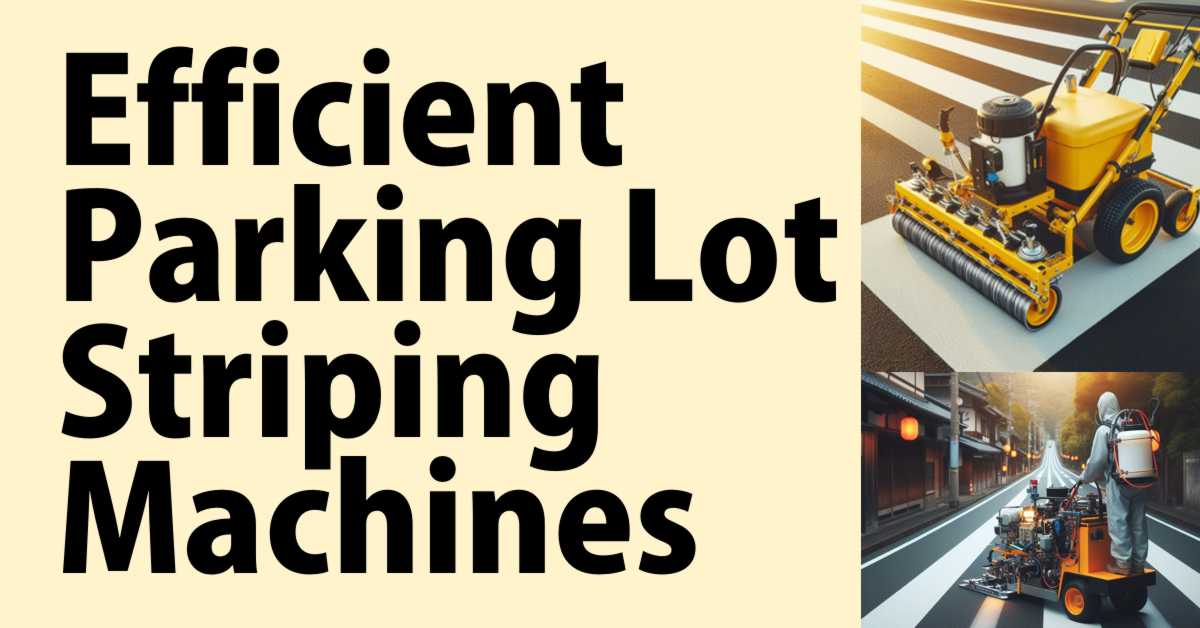As a licensed civil engineer and construction specialist with over 25 years of experience in asphalt materials, specifications, and roadway construction, I have witnessed firsthand the transformative impact of advanced striping machines on parking lot projects. These specialized machines have revolutionized how we approach striping, offering unparalleled precision, efficiency, and quality in application.
The Evolution of Striping Machines
From Manual to Automated
In the early days of parking lot striping, the process was predominantly manual, relying on skilled workers and hand-held tools to apply marking materials. While this approach was effective, it was time-consuming, labor-intensive, and prone to inconsistencies. The introduction of striping machines marked a significant leap forward, automating the application process and ensuring consistent, high-quality results.
Advancements in Technology
Over the years, striping machines have undergone remarkable technological advancements, incorporating features such as computer-controlled operation, GPS guidance systems, and advanced material handling capabilities. These advancements have not only improved efficiency and accuracy but have also expanded the range of applications and materials that can be utilized.
Types of Striping Machines
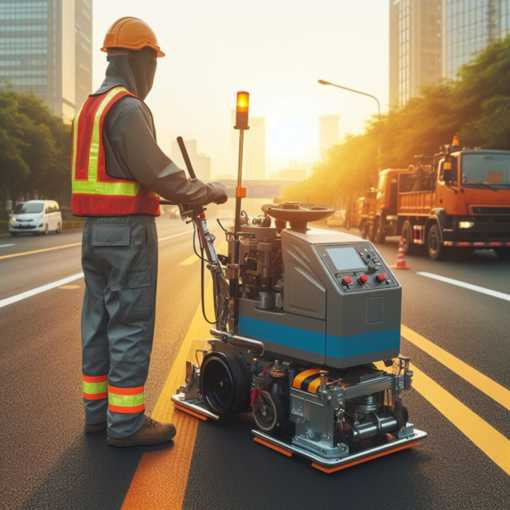
Walk-Behind Striping Machines
Walk-behind striping machines are compact and maneuverable, making them well-suited for smaller parking lots or areas with tight spaces. These machines typically feature a push-style operation, allowing the operator to precisely guide the striping process.
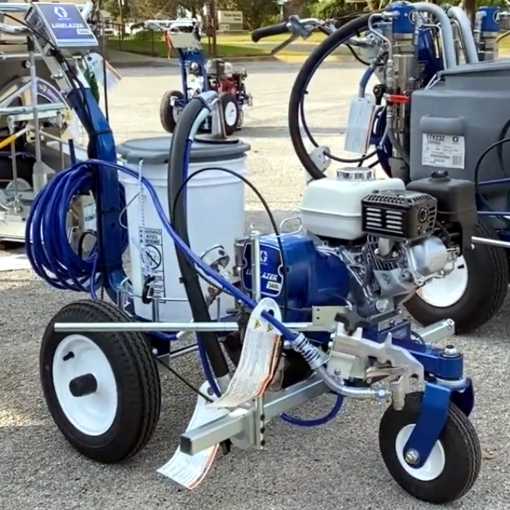
Key Features
- Compact and lightweight design
- Adjustable line widths
- Suitable for a variety of marking materials (e.g., paints, thermoplastics)
- Ideal for touch-ups and smaller projects
Key Takeaways:
- Walk-behind striping machines offer unparalleled precision, control, and efficiency in pavement marking applications.
- Careful consideration of factors such as marking material compatibility, line width adjustability, and ergonomics is essential when selecting the right machine.
- Proper surface preparation, calibration, and striping techniques are crucial for achieving high-quality, consistent pavement markings.
- Regular maintenance, cleaning, and troubleshooting are necessary to ensure the long-term reliability and performance of walk-behind striping machines.
- Safety should be a top priority, with the use of appropriate personal protective equipment and proper work zone setup.
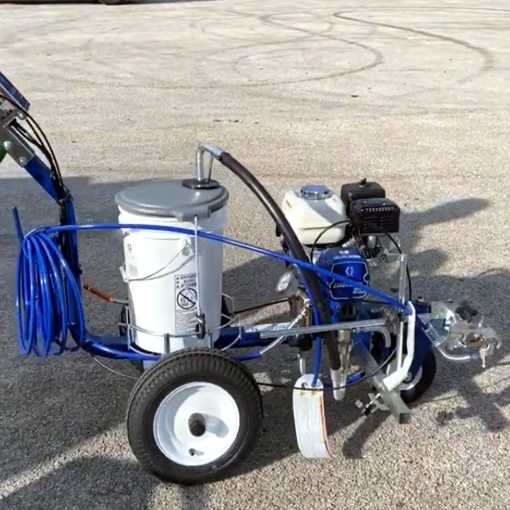
Benefits of Using Walk-Behind Striping Machines
Increased Precision and Control
Walk-behind stripping machines offer a high level of precision and control, allowing operators to apply accurate and consistent pavement markings. This is particularly beneficial in areas with tight spaces, intricate designs, or the need for detailed line work.
Improved Efficiency and Productivity
Compared to manual paint application methods, walk-behind striping machines can significantly increase the efficiency and productivity of pavement marking projects. These machines can cover larger areas in less time, resulting in cost savings and reduced labor requirements.
Enhanced Safety
The use of walk-behind striping machines can contribute to improved safety on construction sites and during pavement marking operations. These machines eliminate the need for workers to manually handle and apply paint or thermoplastic materials, reducing the risk of exposure to hazardous substances and potential accidents.
Versatility and Adaptability
Walk-behind striping machines are designed to handle a variety of pavement marking applications, from simple line striping to complex patterns and symbols. They can be used on different types of paved surfaces, including asphalt, concrete, and even brick or pavers.
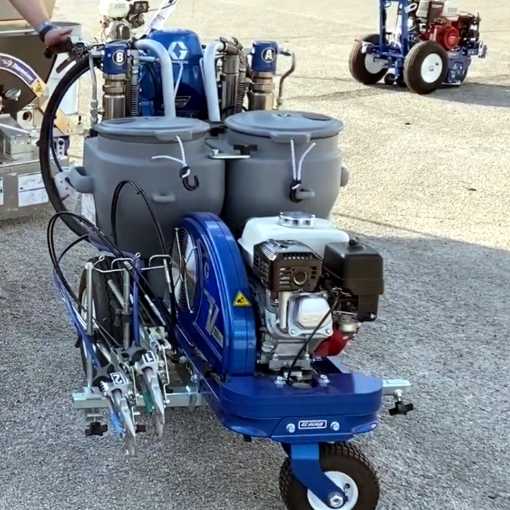
Types of Walk-Behind Striping Machines
Walk-behind striping machines can be categorized based on the type of marking material they are designed to apply:
Paint Striping Machines:
These machines are used for applying liquid paint-based markings on pavement surfaces.
Thermoplastic Striping Machines:
These machines are equipped to apply thermoplastic, a heated and molten material that adheres to the pavement surface.
Combination Striping Machines:
Some models are capable of handling both paint and thermoplastic materials, providing versatility in pavement marking applications.
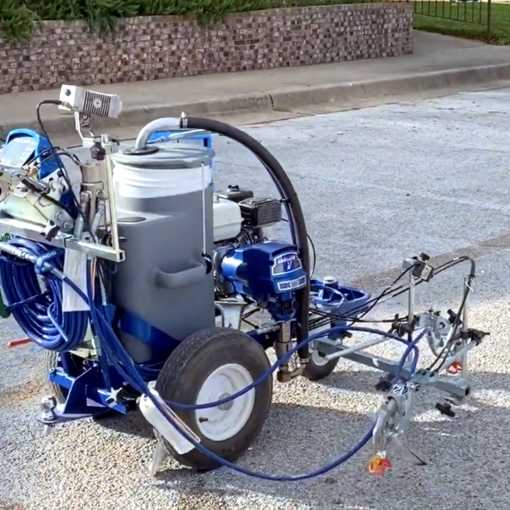
Here is a comparison table that covers the key aspects between paint striping machines, thermoplastic striping machines, and combination striping machines:
| Feature | Paint Striping Machines | Thermoplastic Striping Machines | Combination Striping Machines |
|---|---|---|---|
| Marking Material | Liquid paint | Thermoplastic (heated, molten material) | Can handle both paint and thermoplastic |
| Application Process | Sprayed onto the pavement surface | Melted and applied onto the pavement surface | Can apply both paint and thermoplastic |
| Surface Preparation | Requires clean, dry surface | Requires clean, dry surface | Can accommodate both paint and thermoplastic surface requirements |
| Curing Time | Dries quickly, typically 15-30 minutes | Requires longer curing time, up to 30 minutes | Curing time depends on the material used |
| Durability | Moderate to high, depending on the paint type | High, very durable, and long-lasting | Durability depends on the material used |
| Reflectivity | Can be enhanced with glass beads | Inherently reflective | Reflectivity depends on the material used |
| Operating Temperature | Can be used in a wide range of temperatures | Requires higher operating temperatures, typically 400°F+ | Temperature requirements depend on the material used |
| Clean-up | Easier clean-up with solvents | Requires specialized clean-up methods for thermoplastic | Clean-up methods depend on the material used |
| Versatility | Suitable for various line types and patterns | Best for solid, continuous lines | Versatile for different line types and patterns |
| Initial Cost | Generally lower than thermoplastic | The higher initial cost for equipment and materials | Typically higher initial cost than paint or thermoplastic machines |
| Operational Cost | Relatively lower ongoing costs | Higher operating costs due to material and energy requirements | Operational costs depend on the material used |
| Maintenance | Requires regular cleaning and flushing | More complex maintenance due to the thermoplastic system | Maintenance requirements depend on the components used |
This comparison table provides a comprehensive overview of the key differences between paint striping machines, thermoplastic striping machines, and combination striping machines, covering aspects such as marking material, application process, surface preparation, curing time, durability, reflectivity, operating temperature, clean-up, versatility, and cost considerations. This information is based on my 25+ years of experience and it can help you make an informed decision when selecting the appropriate type of walk-behind striping machine for your specific pavement marking needs.
Factors to Consider When Choosing a Walk-Behind Striping Machine
Marking Material Compatibility
When selecting a walk-behind striping machine, it’s crucial to consider the type of marking material you’ll be using, such as paint or thermoplastic. Ensure that the machine is compatible with the specific material to ensure proper application and adhesion to the pavement surface.
Line Width and Adjustability
Different projects may require varying line widths, so look for machines that offer adjustable line width settings. This allows you to accommodate different striping requirements and maintain consistent markings throughout the project.
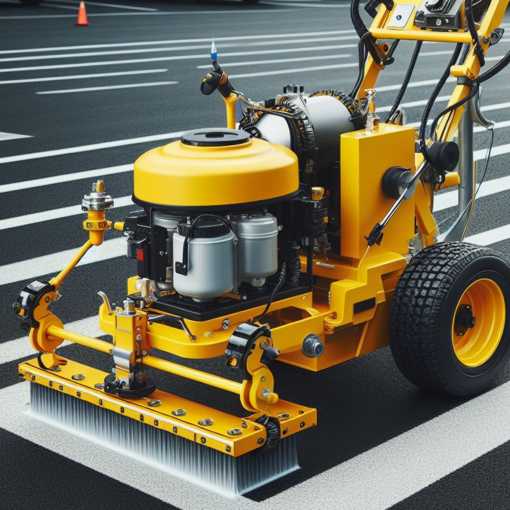
Power Source and Engine Considerations
Walk-behind striping machines can be powered by either gas-powered engines or electric motors. Consider the power requirements of your project, as well as any noise or emission regulations that may apply in your area.
Hopper Capacity and Refill Frequency
The size of the paint or thermoplastic hopper on the machine will determine how often you’ll need to refill it during the striping process. Larger hopper capacities can help minimize downtime and increase productivity.
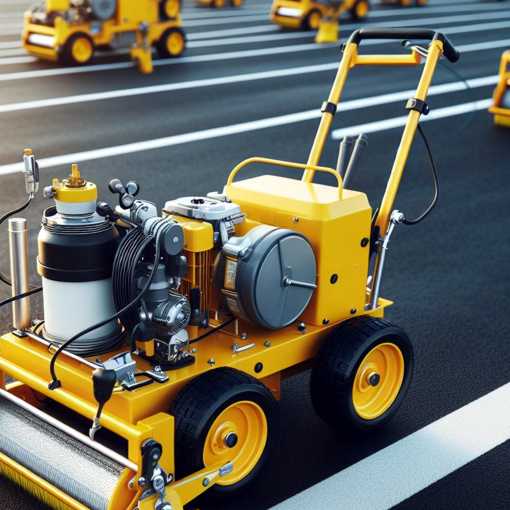
Maneuverability and Ergonomics
Look for machines with features that enhance maneuverability, such as swivel wheels or adjustable handles. Additionally, consider the ergonomics of the machine, including the handle height and overall weight, to ensure comfortable and fatigue-free operation.
Maintenance and Serviceability
Evaluate the maintenance requirements of the walk-behind striping machine, including access to replacement parts and the ease of performing routine maintenance tasks. This will help ensure the longevity and reliable performance of the equipment.
Preparing the Pavement Surface for Striping
Surface Inspection and Cleaning
Before applying pavement markings with a walk-behind striping machine, it’s essential to thoroughly inspect and clean the surface. Remove any debris, oil, or other contaminants that could interfere with the adhesion of the marking material.
Repairs and Surface Preparation
If the pavement surface has any cracks, potholes, or other defects, it’s crucial to address them before proceeding with the striping process. Repairs may include patching, sealing, or resurfacing the affected areas to ensure a smooth, uniform surface for the pavement markings.
Environmental Considerations
Weather conditions can significantly impact the success of pavement marking applications. Consider factors such as temperature, humidity, and precipitation when planning your striping project to ensure optimal adhesion and durability of the markings.
Applying Pavement Markings with a Walk-Behind Striping Machine
Pre-Striping Calibration and Setup
Before beginning the striping process, it’s important to properly calibrate the walk-behind striping machine. This may include adjusting the flow rate, line width, and other settings to ensure accurate and consistent application of the marking material.
Proper Striping Techniques
Operating a walk-behind striping machine requires a certain level of skill and technique. Maintain a steady pace, keep the spray gun or applicator at the correct height and angle, and apply the marking material in a continuous, smooth motion to achieve the best results.
Maintaining Consistent Line Quality
Ensuring consistent line quality is crucial for the visual appeal and safety of pavement markings. Pay close attention to factors such as overlapping, gaps, and variations in line thickness throughout the striping process.
Handling Intersections, Curves, and Corners
Navigating through intersections, curves, and corners can be a challenge when using a walk-behind striping machine. Employ techniques such as overlapping, pivoting, and adjusting the machine’s speed to maintain the desired line quality in these areas.
Maintenance and Care for Walk-Behind Striping Machines
Regular Cleaning and Flushing
Proper maintenance of a walk-behind striping machine is essential to ensure its longevity and consistent performance. Regularly clean the machine, including the spray gun or applicator, and flush the system to prevent clogging and buildup of dried marking material.
Storage and Off-Season Care
When the striping season comes to an end, it’s important to properly store the walk-behind striping machine. This may include draining any remaining marking material, cleaning the machine thoroughly, and protecting it from the elements during the off-season.
Troubleshooting Common Issues
Familiarize yourself with common issues that may arise with walk-behind striping machines, such as clogged nozzles, uneven line application, or engine problems. Develop a troubleshooting process to quickly identify and resolve these issues to minimize downtime.
Comparing Walk-Behind Striping Machines: Features and Specifications
To help you make an informed decision when selecting a walk-behind striping machine, I’ve compiled a comparison table highlighting key features and specifications:
| Feature/Specification | Machine A | Machine B | Machine C |
|---|---|---|---|
| Marking Material | Paint | Thermoplastic | Combination |
| Engine/Motor Type | Gas | Electric | Hybrid |
| Horsepower | 5 HP | 2 HP | 4 HP |
| Hopper Capacity | 5 gallons | 50 lbs | 10 gallons |
| Line Width Range | 2-6 inches | 4-12 inches | 2-12 inches |
| Adjustable Line Width | Yes | Yes | Yes |
| Wheels and Steering | Pneumatic, Swivel | Solid, Swivel | Pneumatic, Adjustable |
| Dimensions (L x W x H) | 48 x 24 x 36 in | 36 x 18 x 42 in | 54 x 28 x 40 in |
| Weight | 150 lbs | 120 lbs | 185 lbs |
| Noise Level | 75 dB | 65 dB | 72 dB |
| Warranty | 1 year | 2 years | 3 years |
Safety Considerations for Walk-Behind Striping Machines
Personal Protective Equipment (PPE)
When operating a walk-behind striping machine, it’s crucial to wear the appropriate personal protective equipment, such as safety glasses, gloves, and high-visibility clothing, to minimize the risk of exposure to hazardous materials and ensure your safety.
Traffic Control and Work Zone Setup
Proper traffic control measures and work zone setup are essential when using a walk-behind striping machine on active roadways or parking lots. This may include the use of cones, signs, and traffic control devices to ensure the safety of both the operator and the public.
Operator Training and Certification
Ensure that any personnel operating a walk-behind striping machine are properly trained and, if required, certified in the safe and efficient use of this equipment. This will help prevent accidents and ensure the quality of the pavement markings.
Cost Considerations for Walk-Behind Striping Machines
Purchase or Rental Options
Depending on the frequency and scale of your pavement marking projects, you may consider purchasing a walk-behind striping machine or renting one. Factors such as upfront cost, maintenance requirements, and utilization rate should be taken into account when making this decision.
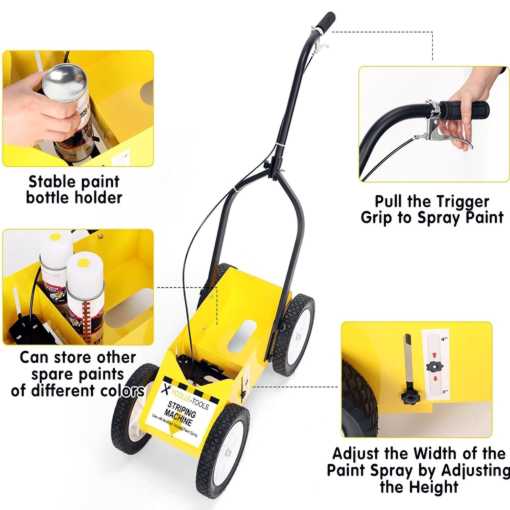
Operational and Maintenance Costs
In addition to the initial purchase or rental cost, you’ll need to factor in ongoing operational and maintenance expenses, such as fuel, lubricants, replacement parts, and regular servicing, to ensure the longevity and reliable performance of your walk-behind striping machine.
Cost-Benefit Analysis
Carefully evaluate the cost-benefit analysis of using a walk-behind striping machine versus alternative pavement marking methods, such as manual application or hiring a professional striping contractor. This can help you determine the most cost-effective solution for your specific project requirements.
Ride-On Striping Machines
Ride-on striping machines are larger and more powerful, designed to tackle extensive parking lot projects with ease. These machines are equipped with advanced features and material handling systems, ensuring consistent and efficient application over large areas.
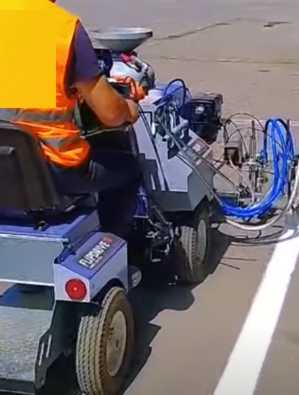
Key Features
- Robust and durable construction
- Computer-controlled operation
- GPS guidance systems for precision
- Ability to handle high-volume material applications
- Suitable for a wide range of marking materials
Key Takeaways:
- Ride-on striping machines offer significant improvements in productivity, efficiency, and consistency compared to manual or walk-behind striping methods.
- Careful consideration of factors such as marking material compatibility, engine power, hopper capacity, and ergonomics is essential when selecting the right ride-on striping machine.
- Proper surface preparation, calibration, and striping techniques are crucial for achieving high-quality, uniform pavement markings.
- Regular maintenance, cleaning, and troubleshooting are necessary to ensure the long-term reliability and performance of ride-on striping machines.
- Safety should be a top priority, with the use of appropriate personal protective equipment and proper work zone setup.
Benefits of Using Ride-On Striping Machines
Increased Productivity and Efficiency
Ride-on striping machines offer a significant advantage in terms of productivity and efficiency compared to manual or walk-behind striping methods. These self-propelled machines can cover larger areas in less time, allowing for faster completion of pavement marking projects.
Enhanced Operator Comfort and Safety
By providing a seated and ergonomic working position, ride-on striping machines reduce the physical strain and fatigue experienced by operators, improving their comfort and overall safety during long hours of operation.
Consistent and Uniform Pavement Markings
The precision and control offered by ride-on striping machines enable the application of highly consistent and uniform pavement markings, ensuring a professional and aesthetically pleasing result.
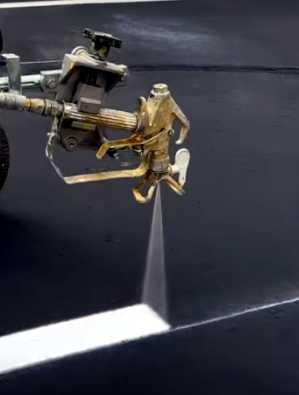
Versatility and Adaptability
Ride-on stripping machines are designed to handle a wide range of pavement marking applications, from simple line striping to complex patterns and symbols. They can be used on various paved surfaces, including asphalt, concrete, and even specialized surfaces such as athletic courts or playgrounds.
Reduced Labor Requirements
The increased productivity and efficiency of ride-on striping machines can significantly reduce the number of personnel required for pavement marking projects, leading to cost savings and increased project flexibility.
Factors to Consider When Choosing a Ride-On Striping Machine
Marking Material Compatibility
When selecting a ride-on striping machine, it’s crucial to consider the type of marking material you’ll be using, such as paint or thermoplastic. Ensure that the machine is compatible with the specific material to ensure proper application and adhesion to the pavement surface.
Line Width and Adjustability
Different projects may require varying line widths, so look for machines that offer adjustable line width settings. This allows you to accommodate different striping requirements and maintain consistent markings throughout the project.
Engine Power and Drivetrain
The engine power and drivetrain of the ride-on striping machine will determine its ability to navigate various terrain and pavement conditions, as well as its overall speed and maneuverability.
Hopper Capacity and Refill Frequency
The size of the paint or thermoplastic hopper on the machine will determine how often you’ll need to refill it during the striping process. Larger hopper capacities can help minimize downtime and increase productivity.
Operator Comfort and Ergonomics
Consider the ergonomic features of the ride-on striping machine, such as the seat design, control layout, and visibility, to ensure a comfortable and efficient operating experience for the user.
Maintenance and Serviceability
Evaluate the maintenance requirements of the ride-on striping machine, including access to replacement parts and the ease of performing routine maintenance tasks. This will help ensure the longevity and reliable performance of the equipment.
Preparing the Pavement Surface for Striping
Surface Inspection and Cleaning
Before applying pavement markings with a ride-on striping machine, it’s essential to thoroughly inspect and clean the surface. Remove any debris, oil, or other contaminants that could interfere with the adhesion of the marking material.
Repairs and Surface Preparation
If the pavement surface has any cracks, potholes, or other defects, it’s crucial to address them before proceeding with the striping process. Repairs may include patching, sealing, or resurfacing the affected areas to ensure a smooth, uniform surface for the pavement markings.
Environmental Considerations
Weather conditions can significantly impact the success of pavement marking applications. Consider factors such as temperature, humidity, and precipitation when planning your striping project to ensure optimal adhesion and durability of the markings.
Applying Pavement Markings with a Ride-On Striping Machine
Pre-Striping Calibration and Setup
Before beginning the striping process, it’s important to properly calibrate the ride-on striping machine. This may include adjusting the flow rate, line width, and other settings to ensure accurate and consistent application of the marking material.
Proper Striping Techniques
Operating a ride-on striping machine requires a certain level of skill and technique. Maintain a steady pace, keep the spray gun or applicator at the correct height and angle, and apply the marking material in a continuous, smooth motion to achieve the best results.
Maintaining Consistent Line Quality
Ensuring consistent line quality is crucial for the visual appeal and safety of pavement markings. Pay close attention to factors such as overlapping, gaps, and variations in line thickness throughout the striping process.
Navigating Intersections, Curves, and Corners
Maneuvering through intersections, curves, and corners can be a challenge when using a ride-on striping machine. Employ techniques such as overlapping, pivoting, and adjusting the machine’s speed to maintain the desired line quality in these areas.
Maintenance and Care for Ride-On Striping Machines
Regular Cleaning and Flushing
Proper maintenance of a ride-on striping machine is essential to ensure its longevity and consistent performance. Regularly clean the machine, including the spray gun or applicator, and flush the system to prevent clogging and buildup of dried marking material.
Storage and Off-Season Care
When the striping season comes to an end, it’s important to properly store the ride-on striping machine. This may include draining any remaining marking material, cleaning the machine thoroughly, and protecting it from the elements during the off-season.
Troubleshooting Common Issues
Familiarize yourself with common issues that may arise with ride-on striping machines, such as clogged nozzles, uneven line application, or engine problems. Develop a troubleshooting process to quickly identify and resolve these issues to minimize downtime.
Comparing Ride-On Striping Machines: Features and Specifications
To help you make an informed decision when selecting a ride-on striping machine, I’ve compiled a comparison table highlighting key features and specifications:
| Feature/Specification | Machine A | Machine B | Machine C |
|---|---|---|---|
| Marking Material | Paint | Thermoplastic | Combination |
| Engine Type | Gasoline | Diesel | Hybrid |
| Horsepower | 20 HP | 25 HP | 18 HP |
| Hopper Capacity | 50 gallons | 800 lbs | 40 gallons |
| Line Width Range | 4-12 inches | 6-12 inches | 4-12 inches |
| Adjustable Line Width | Yes | Yes | Yes |
| Wheels and Suspension | Pneumatic, Independent | Solid, Adjustable | Pneumatic, Coil-Over |
| Dimensions (L x W x H) | 96 x 48 x 60 in | 108 x 54 x 72 in | 102 x 50 x 66 in |
| Weight | 1,200 lbs | 1,500 lbs | 1,350 lbs |
| Maximum Speed | 10 mph | 12 mph | 8 mph |
| Noise Level | 80 dB | 85 dB | 78 dB |
| Warranty | 2 years | 3 years | 2 years |
Safety Considerations for Ride-On Striping Machines
Personal Protective Equipment (PPE)
When operating a ride-on striping machine, it’s crucial to wear the appropriate personal protective equipment, such as safety glasses, gloves, and high-visibility clothing, to minimize the risk of exposure to hazardous materials and ensure your safety.
Operator Training and Certification
Ensure that any personnel operating a ride-on striping machine are properly trained and, if required, certified in the safe and efficient use of this equipment. This will help prevent accidents and ensure the quality of the pavement markings.
Work Zone Setup and Traffic Control
Proper work zone setup and traffic control measures are essential when using a ride-on striping machine on active roadways or parking lots. This may include the use of cones, signs, and traffic control devices to ensure the safety of both the operator and the public.
Cost Considerations for Ride-On Striping Machines
Purchase or Rental Options
Depending on the frequency and scale of your pavement marking projects, you may consider purchasing a ride-on striping machine or renting one. Factors such as upfront cost, maintenance requirements, and utilization rate should be taken into account when making this decision.
Operational and Maintenance Costs
In addition to the initial purchase or rental cost, you’ll need to factor in ongoing operational and maintenance expenses, such as fuel, lubricants, replacement parts, and regular servicing, to ensure the longevity and reliable performance of your ride-on striping machine.
Cost-Benefit Analysis
Carefully evaluate the cost-benefit analysis of using a ride-on striping machine versus alternative pavement marking methods, such as manual application or hiring a professional striping contractor. This can help you determine the most cost-effective solution for your specific project requirements.
Rde-on striping machines have become an indispensable tool in the world of pavement marking and road construction. As a licensed civil engineer and construction specialist with over 25 years of experience, I can attest to the numerous benefits these machines offer, from increased productivity and efficiency to enhanced operator comfort and safety.
By understanding the key components, types, and factors to consider when choosing a ride-on striping machine, you can make informed decisions that will maximize the success of your pavement marking projects. Proper preparation, application techniques, and maintenance are crucial to ensuring the longevity and performance of these versatile machines.
Truck-Mounted Striping Machines
Truck-mounted striping machines are the ultimate solution for large-scale parking lot projects and roadway striping applications. These machines are mounted on specialized trucks, allowing for unmatched mobility and material-carrying capacity.
Key Features
- Mounted on a truck or trailer for mobility
- Large material holding tanks
- Automated material handling and application systems
- Suitable for high-volume projects and roadway striping
- Ability to handle multiple types of marking materials
Key Takeaways:
- Truck-mounted striping machines offer significant improvements in productivity, efficiency, and coverage compared to manual or walk-behind striping methods.
- Careful consideration of factors such as marking material compatibility, truck size and chassis compatibility, and advanced guidance systems is essential when selecting the right truck-mounted striping machine.
- Proper surface preparation, calibration, and striping techniques are crucial for achieving high-quality, uniform pavement markings.
- Regular maintenance, cleaning, and troubleshooting are necessary to ensure the long-term reliability and performance of truck-mounted striping machines.
- Safety should be a top priority, with the use of appropriate personal protective equipment and proper work zone setup.
Benefits of Using Truck-Mounted Striping Machines
Increased Productivity and Efficiency
Truck-mounted striping machines offer significantly higher productivity and efficiency compared to manual or walk-behind striping methods. By leveraging the mobility and power of a truck, these machines can cover large areas at a much faster rate, improving the overall productivity of pavement marking projects.
Extended Reach and Coverage
The use of booms and outriggers on truck-mounted striping machines allows for the application of pavement markings over a wider area, reducing the need for multiple passes or additional equipment.
Improved Safety and Reduced Labor Requirements
Truck-mounted striping machines eliminate the need for workers to manually handle and apply paint or thermoplastic materials, reducing the risk of exposure to hazardous substances and potential accidents. This also leads to a decrease in the number of personnel required for pavement marking projects.
Consistent and Uniform Pavement Markings
The precision and control offered by truck-mounted striping machines enable the application of highly consistent and uniform pavement markings, ensuring a professional and aesthetically pleasing result.
Versatility and Adaptability
Truck-mounted striping machines are designed to handle a wide range of pavement marking applications, from simple line striping to complex patterns and symbols. They can be used on various paved surfaces, including asphalt, concrete, and even specialized surfaces such as athletic courts or playgrounds.
Factors to Consider When Choosing a Truck-Mounted Striping Machine
Marking Material Compatibility
When selecting a truck-mounted striping machine, it’s crucial to consider the type of marking material you’ll be using, such as paint or thermoplastic. Ensure that the machine is compatible with the specific material to ensure proper application and adhesion to the pavement surface.
Line Width and Adjustability
Different projects may require varying line widths, so look for machines that offer adjustable line width settings. This allows you to accommodate different striping requirements and maintain consistent markings throughout the project.
Truck Size and Chassis Compatibility
The size and weight of the truck-mounted striping machine must be compatible with the truck chassis and its load-bearing capacity. Carefully consider the dimensions, weight, and power requirements of the machine to ensure a proper fit and safe operation.
Hopper or Tank Capacity
The size of the paint or thermoplastic tanks on the machine will determine how often you’ll need to refill during the striping process. Larger capacities can help minimize downtime and increase productivity.
Computerized Guidance Systems
Some advanced truck-mounted striping machines feature computerized guidance systems, such as GPS or laser-guided technology, to ensure accurate and consistent pavement markings. Evaluate the benefits of these systems for your specific project needs.
Maintenance and Serviceability
Assess the maintenance requirements of the truck-mounted striping machine, including access to replacement parts and the ease of performing routine maintenance tasks. This will help ensure the longevity and reliable performance of the equipment.
Preparing the Pavement Surface for Striping
Surface Inspection and Cleaning
Before applying pavement markings with a truck-mounted striping machine, it’s essential to thoroughly inspect and clean the surface. Remove any debris, oil, or other contaminants that could interfere with the adhesion of the marking material.
Repairs and Surface Preparation
If the pavement surface has any cracks, potholes, or other defects, it’s crucial to address them before proceeding with the striping process. Repairs may include patching, sealing, or resurfacing the affected areas to ensure a smooth, uniform surface for the pavement markings.
Environmental Considerations
Weather conditions can significantly impact the success of pavement marking applications. Consider factors such as temperature, humidity, and precipitation when planning your striping project to ensure optimal adhesion and durability of the markings.
Applying Pavement Markings with a Truck-Mounted Striping Machine
Pre-Striping Calibration and Setup
Before beginning the striping process, it’s important to properly calibrate the truck-mounted striping machine. This may include adjusting the flow rate, line width, and other settings to ensure accurate and consistent application of the marking material.
Proper Striping Techniques
Operating a truck-mounted striping machine requires a certain level of skill and technique. Maintain a steady speed, keep the spray guns or applicators at the correct height and angle, and apply the marking material in a continuous, smooth motion to achieve the best results.
Maintaining Consistent Line Quality
Ensuring consistent line quality is crucial for the visual appeal and safety of pavement markings. Pay close attention to factors such as overlapping, gaps, and variations in line thickness throughout the striping process.
Navigating Intersections, Curves, and Corners
Maneuvering through intersections, curves, and corners can be a challenge when using a truck-mounted striping machine. Employ techniques such as overlapping, pivoting, and adjusting the machine’s speed to maintain the desired line quality in these areas.
Maintenance and Care for Truck-Mounted Striping Machines
Regular Cleaning and Flushing
Proper maintenance of a truck-mounted striping machine is essential to ensure its longevity and consistent performance. Regularly clean the machine, including the spray guns or applicators, and flush the system to prevent clogging and buildup of dried marking material.
Storage and Off-Season Care
When the striping season comes to an end, it’s important to properly store the truck-mounted striping machine. This may include draining any remaining marking material, cleaning the machine thoroughly, and protecting it from the elements during the off-season.
Troubleshooting Common Issues
Familiarize yourself with common issues that may arise with truck-mounted striping machines, such as clogged nozzles, uneven line application, or engine problems. Develop a troubleshooting process to quickly identify and resolve these issues to minimize downtime.
Comparing Truck-Mounted Striping Machines:
Features and Specifications
To help you make an informed decision when selecting a truck-mounted striping machine, I’ve compiled a comparison table highlighting key features and specifications:
| Feature/Specification | |||
|---|---|---|---|
| Marking Material | Paint | Thermoplastic | Combination |
| Truck Size | 1-ton | 2-ton | 3-ton |
| Engine Type | Gasoline | Diesel | Hybrid |
| Horsepower | 150 HP | 180 HP | 200 HP |
| Tank Capacity | 100 gallons | 3,000 lbs | 150 gallons |
| Line Width Range | 4-12 inches | 6-12 inches | 4-12 inches |
| Adjustable Line Width | Yes | Yes | Yes |
| Boom and Outrigger | 12 ft | 16 ft | 18 ft |
| Computerized Guidance | No | GPS | GPS, Laser |
| Dimensions (L x W x H) | 240 x 96 x 120 in | 276 x 102 x 132 in | 288 x 108 x 144 in |
| Weight | 8,500 lbs | 12,000 lbs | 15,000 lbs |
| Maximum Speed | 50 mph | 55 mph | 60 mph |
| Noise Level | 85 dB | 90 dB | 88 dB |
| Warranty | 2 years | 3 years | 3 years |
Safety Considerations for Truck-Mounted Striping Machines
Personal Protective Equipment (PPE)
When operating a truck-mounted striping machine, it’s crucial to wear the appropriate personal protective equipment, such as safety glasses, gloves, and high-visibility clothing, to minimize the risk of exposure to hazardous materials and ensure your safety.
Operator Training and Certification
Ensure that any personnel operating a truck-mounted striping machine are properly trained and, if required, certified in the safe and efficient use of this equipment. This will help prevent accidents and ensure the quality of the pavement markings.
Work Zone Setup and Traffic Control
Proper work zone setup and traffic control measures are essential when using a truck-mounted striping machine on active roadways or highways. This may include the use of cones, signs, and traffic control devices to ensure the safety of both the operator and the public.
Cost Considerations for Truck-Mounted Striping Machines
Purchase or Rental Options
Depending on the frequency and scale of your pavement marking projects, you may consider purchasing a truck-mounted striping machine or renting one. Factors such as upfront cost, maintenance requirements, and utilization rate should be taken into account when making this decision.
Operational and Maintenance Costs
In addition to the initial purchase or rental cost, you’ll need to factor in ongoing operational and maintenance expenses, such as fuel, lubricants, replacement parts, and regular servicing, to ensure the longevity and reliable performance of your truck-mounted stripping machine.
Cost-Benefit Analysis
Carefully evaluate the cost-benefit analysis of using a truck-mounted striping machine versus alternative pavement marking methods, such as manual application or hiring a professional striping contractor. This can help you determine the most cost-effective solution for your specific project requirements.
Advantages of Using Striping Machines
Precision and Consistency
One of the primary advantages of using striping machines is the precision and consistency they offer in application. These machines are designed to maintain consistent line widths, spacing, and material coverage, ensuring a professional and uniform appearance throughout the parking lot.
Increased Efficiency and Productivity
By automating the striping process, these machines significantly increase efficiency and productivity compared to manual methods. They can cover larger areas in a shorter period, minimizing labor costs and reducing project timelines.
Improved Safety and Accessibility
Well-executed striping is crucial for ensuring safety and accessibility in parking lots. Striping machines help achieve clear and compliant markings, delineating traffic lanes, parking spaces, and pedestrian walkways, ultimately enhancing the overall safety and usability of the facility.
Striping Machine Operations and Maintenance
Operator Training and Certification
Proper training and certification are essential for the safe and effective operation of striping machines. Manufacturers typically offer comprehensive training programs to ensure operators are well-versed in machine operation, safety protocols, and maintenance procedures.
Material Handling and Preparation
Striping machines require careful material handling and preparation to ensure optimal performance. This may involve mixing and heating materials to the appropriate temperatures, as well as ensuring proper material flow and consistency during application.
Routine Maintenance and Calibration
Regular maintenance and calibration are crucial for maintaining the accuracy and efficiency of striping machines. This includes cleaning and replacing worn parts, calibrating application systems, and ensuring proper alignment and functionality of all components.
Parking Lot Striping Machine Dataset
To provide a comprehensive understanding of parking lot striping machines, I have compiled the following dataset tables:
Table 1: Design and Performance Specifications
| Specification | Walk-Behind | Ride-On | Truck-Mounted |
|---|---|---|---|
| Line Width Range | 2″ – 8″ (5 – 20 cm) | 2″ – 12″ (5 – 30 cm) | 2″ – 24″ (5 – 60 cm) |
| Material Capacity | 5 – 15 gallons (19 – 57 liters) | 50 – 200 gallons (189 – 757 liters) | 500 – 1,000 gallons (1,893 – 3,785 liters) |
| Application Speed | Up to 5 mph (8 km/h) | Up to 10 mph (16 km/h) | Up to 15 mph (24 km/h) |
| Typical Coverage Rate | 1,000 – 3,000 sq. ft./hr (93 – 279 sq. m/hr) | 5,000 – 15,000 sq. ft./hr (465 – 1,394 sq. m/hr) | 20,000+ sq. ft./hr (1,858+ sq. m/hr) |
Table 2: Safety and Operational Considerations
| Consideration | Description |
|---|---|
| Operator Training | Comprehensive training on machine operation, safety protocols, and maintenance procedures. |
| Personal Protective Equipment (PPE) | Appropriate PPE, such as safety glasses, gloves, and respiratory protection, should be worn during operation. |
| Traffic Control | Proper traffic control measures, including signage and barricades, should be implemented during striping operations. |
| Environmental Considerations | Adherence to local regulations regarding noise levels, emissions, and disposal of materials. |
| Maintenance and Calibration | Regular maintenance and calibration are essential for ensuring optimal performance and accuracy. |
Table 3: Cost Considerations
| Cost Factor | Description |
|---|---|
| Machine Purchase or Rental | The initial cost of purchasing or renting a striping machine can vary significantly based on the type and features. |
| Operator Training and Certification | Trained and certified operators may command higher wages or require additional training investments. |
| Material Costs | The cost of marking materials, such as paints, thermoplastics, or specialized coatings, can vary based on quality and quantity. |
| Maintenance and Repairs | Regular maintenance and potential repairs can contribute to ongoing operational costs. |
| Transportation and Logistics | For larger machines, transportation and logistics costs may need to be factored in for efficient deployment. |
Throughout my career, I have had the privilege of working with various types of striping machines, from compact walk-behind models to powerful truck-mounted systems. Each project has presented its unique challenges and opportunities, allowing me to continuously refine my skills and expand my knowledge in this specialized field.
Parking lot striping machines have revolutionized how we approach striping projects, offering unparalleled precision, efficiency, and quality in application. From compact walk-behind units to powerful truck-mounted systems, these machines are designed to meet the diverse needs of parking lot projects, ensuring clear and compliant markings that enhance safety and accessibility.
As a licensed civil engineer and construction specialist with over 25 years of experience in asphalt materials, specifications, and roadway construction, I have witnessed firsthand the transformative impact of these machines. By leveraging advanced technology, automation, and material handling capabilities, striping machines have streamlined the application process, minimizing labor costs, and reducing project timelines.
Last Words and Key Takeaways
- Invest in specialized striping machines to achieve consistent, high-quality results and maximize efficiency.
- Prioritize operator training and certification to ensure safe and effective machine operation.
- Consider the project scope, material requirements, and logistical needs when selecting the appropriate striping machine.
- Implement proper maintenance and calibration protocols to maintain the accuracy and longevity of the equipment.
- Explore the latest advancements in striping machine technology to stay ahead of the curve and meet evolving project demands.
Personal Experience and Expertise
As Steve Axton, I have dedicated over 25 years to the field of road construction and asphalt pavements, amassing a wealth of knowledge and practical experience. Throughout my career, I have had the opportunity to work with a diverse range of striping machines, from compact walk-behind units to powerful truck-mounted systems.
My expertise extends beyond the operation of striping machines, encompassing a comprehensive understanding of asphalt material specifications, roadway construction techniques, and industry best practices. I take great pride in my ability to provide tailored solutions that meet the unique needs of each project while adhering to the highest standards of quality and safety.
Your Queries answered with my Expertise
What factors should be considered when choosing a striping machine?
When selecting a striping machine, consider factors such as the project size, material requirements, line width range, material capacity, and desired application speed. Additionally, evaluate the machine’s mobility, ease of operation, and maintenance requirements.
How often should striping machines undergo maintenance and calibration?
The frequency of maintenance and calibration can vary based on the manufacturer’s recommendations, usage levels, and operating conditions. However, performing routine maintenance and calibration at regular intervals is generally recommended to ensure optimal performance and accuracy.
Can striping machines handle different types of marking materials?
Yes, most striping machines are designed to handle a variety of marking materials, including paints, thermoplastics, and specialized coatings. However, it’s essential to ensure compatibility between the machine and the chosen material to avoid potential issues or malfunctions.
What safety precautions should be taken when operating striping machines?
Proper safety precautions should be followed, including wearing appropriate personal protective equipment (PPE), implementing traffic control measures, adhering to environmental regulations, and following manufacturer-recommended safety protocols.
How does GPS guidance technology enhance the performance of striping machines?
GPS guidance systems integrated into striping machines allow for precise and accurate application of markings, ensuring consistent line widths, spacing, and adherence to pre-defined patterns or layouts. This technology minimizes human error and improves overall efficiency.
Can striping machines be used for other applications beyond parking lots?
Yes, striping machines can be used for a variety of applications, including roadway striping, athletic field markings, and industrial facility markings. However, the machine selection and configuration may vary depending on the specific application and project requirements.
How do truck-mounted striping machines differ from ride-on or walk-behind models?
Truck-mounted striping machines are designed for large-scale projects and roadway striping applications. They offer increased mobility, larger material holding tanks, and automated material handling and application systems, making them suitable for high-volume projects and efficient coverage of extensive areas.
What factors influence the coverage rate of a striping machine?
The coverage rate of a striping machine is influenced by factors such as the machine’s application speed, line width, material flow rate, and operator proficiency. Additionally, factors like project complexity and material drying or curing times can impact the overall coverage rate.
Can striping machines be rented or leased for short-term projects?
Yes, many equipment rental and leasing companies offer striping machines for short-term or occasional projects. This can be a cost-effective option for contractors or organizations that do not require full-time ownership of the equipment.
How does the cost of striping machines compare to manual application methods?
While the initial investment in a striping machine can be higher compared to manual application methods, the increased efficiency, consistency, and productivity offered by these machines can lead to significant cost savings over time, especially for larger projects or recurring striping needs.
What are the key factors to consider when choosing a walk-behind striping machine?
The key factors to consider include the type of marking material (paint or thermoplastic), line width adjustability, power source (gas or electric), hopper capacity, maneuverability, and maintenance requirements.
How do I properly prepare the pavement surface for striping with a walk-behind machine?
Proper surface preparation involves inspecting the pavement for any defects, cleaning the surface to remove debris and contaminants, and addressing any necessary repairs before applying the pavement markings.
What are the common safety considerations when using a walk-behind striping machine?
Key safety considerations include wearing personal protective equipment (PPE), setting up proper traffic control and work zones, and ensuring that the operator is trained and certified in the safe use of the equipment.
How do I maintain and care for my walk-behind striping machine?
Maintenance tasks include regular cleaning, flushing the system, and proper storage during the off-season. It’s also important to be able to troubleshoot and address common issues that may arise with the machine.
What are the advantages of using a walk-behind striping machine compared to manual pavement marking methods?
The key advantages of using a walk-behind striping machine include increased precision and control, improved efficiency and productivity, enhanced safety, and greater versatility in pavement marking applications.
How do I determine the right walk-behind striping machine for my specific project needs?
Factors to consider include the type of marking material required, the desired line width, the power source, the hopper capacity, and the specific features and capabilities of the machine that align with your project requirements.
What are the cost considerations when investing in a walk-behind striping machine?
Cost considerations include the initial purchase or rental price, as well as ongoing operational and maintenance expenses, such as fuel, lubricants, and replacement parts. Performing a cost-benefit analysis can help you determine the most cost-effective solution.
How can I ensure consistent and high-quality pavement markings when using a walk-behind striping machine?
Proper calibration, technique, and attention to detail are essential. This includes maintaining a steady pace, applying the marking material evenly, and addressing challenges such as intersections, curves, and corners.
What are the environmental factors to consider when using a walk-behind striping machine?
Environmental factors like temperature, humidity, and precipitation can impact the adhesion and performance of pavement markings. It’s important to plan your striping projects accordingly and consider these environmental conditions.
Can walk-behind striping machines handle both paint and thermoplastic materials?
Yes, some walk-behind striping machines are designed as combination machines, allowing them to handle both paint and thermoplastic marking materials, providing greater versatility for your pavement marking needs.
How do I ensure the long-term reliability and performance of my walk-behind striping machine?
Consistent maintenance, including regular cleaning, flushing, and addressing any issues that arise, is crucial to maintaining the long-term reliability and performance of your walk-behind striping machine.
What are the key advantages of using a truck-mounted striping machine over other pavement marking methods?
The key advantages of truck-mounted striping machines include increased productivity and efficiency, extended reach and coverage, improved safety, and the ability to apply highly consistent and uniform pavement markings.
How do I ensure that the truck-mounted striping machine is compatible with my truck chassis?
When selecting a truck-mounted striping machine, it’s crucial to consider the size, weight, and power requirements of the machine to ensure it is compatible with the truck chassis and its load-bearing capacity.
What factors should I consider when choosing the tank or hopper capacity for my truck-mounted striping machine?
The tank or hopper capacity should be based on the scale and duration of your pavement marking projects, as well as the frequency of refilling required to maintain productivity and minimize downtime.
How do I ensure consistent and high-quality pavement markings when using a truck-mounted striping machine?
Proper calibration, technique, and attention to detail are essential. This includes maintaining a steady speed, applying the marking material evenly, and navigating through intersections, curves, and corners effectively.
What are the common maintenance requirements for truck-mounted striping machines?
Regular cleaning, flushing, and addressing any issues that arise are crucial for maintaining the long-term reliability and performance of truck-mounted striping machines. Proper storage and off-season care are also important.
How do I ensure the safety of the operator and the work zone when using a truck-mounted striping machine?
Key safety considerations include the use of personal protective equipment (PPE), proper operator training and certification, and the implementation of comprehensive work zone setup and traffic control measures.
What are the environmental factors to consider when using a truck-mounted striping machine?
Environmental conditions like temperature, humidity, and precipitation can impact the adhesion and performance of pavement markings. It’s essential to plan your striping projects accordingly and consider these environmental factors.
How do I perform a cost-benefit analysis when deciding between purchasing or renting a truck-mounted striping machine?
Factors to consider include the upfront cost, ongoing operational and maintenance expenses, project frequency and scale, and the potential cost savings or productivity gains compared to alternative pavement marking methods.
Can truck-mounted striping machines handle both paint and thermoplastic materials?
Yes, some truck-mounted striping machines are designed as combination machines, allowing them to handle both paint and thermoplastic marking materials, providing greater versatility for your pavement marking needs.
How do I troubleshoot and address common issues that may arise with my truck-mounted striping machine?
Familiarize yourself with the machine’s components and systems, and develop a structured troubleshooting process to quickly identify and resolve problems such as clogged nozzles, uneven line application, or engine-related issues.
What are the key considerations for storage and off-season care of a truck-mounted striping machine?
Proper storage and off-season care, including draining remaining marking material, thorough cleaning, and protecting the machine from the elements, are crucial to ensure its long-term reliability and performance.
